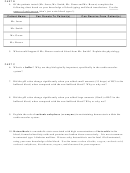Lab: Blood Exploration
ADVERTISEMENT
Name:___________________________________________ Period:_____ Date:_________________
LAB: Blood Exploration
Introduction
A liquid called plasma makes up about half (55%) of the content of blood. Plasma contains proteins
that help blood to clot, transport substances through the blood, and perform other functions. Blood
plasma also contains glucose and other dissolved nutrients. The other half (45%) of blood volume is
composed of blood cells: Red blood cells, which carry oxygen to the tissues and remove carbon
dioxide as waste, white blood cells, which fight infections, and platelets, smaller cells that help blood
to clot. In this lab investigation, we will focus mainly on the structure and function of the RBCs,
examining the various morphologies of blood cells, determining the ABO blood type of individuals,
and exploring the ability of blood to buffer the circulatory system against drastic changes in pH.
PART A – Histology of Blood Smears
Red blood cells (erythrocytes) have a unique structure and properties that allow them to fulfill crucial
functions within the body. They are biconcave discs, having a depressed center on both sides. These
depressed centers allow the cells to have more cell membrane surface which can be exposed to
diffusing oxygen while transiting the lungs. This structure, along with a small size (about 7.8
micrometers) also allows them to be more flexible when negotiating tight passages.
Sometimes structural changes occur in RBCs that indicate a possible pathological
condition. For instance, one may observe enlarged RBCs with folate or vitamin
B12 deficiency (macrocytic anemia). Small RBCs may be observed with iron
deficiency or chronic blood loss (microcytic anemia). Sickle cell anemia is a
condition where a genetic flaw leads to defective hemoglobin that changes shape
under certain conditions. This shape change induces the cell to lose its original
biconcave disc confirmation and take on a more “sickled” appearance.
PART B – Introduction to Blood Typing
Red blood cells also play a role in an individual’s immune system. The basic premise
of your immune system relies on antigens and antibodies. Antigens are glycolipids that
n
antige
your body uses to generate antibodies, which are proteins that attack foreign invaders
that may enter your body, and prevent them from doing harm. Each antigen
produces a specific antibody that will attack a very specific foreign invader.
The surface of erythrocytes contains genetically determined glycolipids called
agglutinogens. Antigens are categorized into blood groups, two of which are the ABO and Rh groups.
There are at least 20 different blood groups in red blood cells; the major group is the ABO system.
Type A has only the A-antigen. Type B has only the B-antigen. Type AB has both A- and B-antigens,
and Type O has neither. Blood type denotes the class of antigens (glycolipids) found on the surface of
the red blood cells. Each person inherits two genes that control the production of ABO antigens. A and
A
B
B are codominant (I
and I
, respectively), and O (i) is recessive. A secondary group is the Rh factor.
85% of the population is known to have the Rh factor, and is said to be Rh+. The 15% that do not are
said to be Rh-.
A-antigens make antibodies (in the plasma) against B-antigens, etc. (This is believed to result from the
presence in the plasma of preformed antibodies, made in response to some common bacteria in the
digestive tract.) O produces both anti-A and anti-B antibodies. AB produces neither. The immune
system does not attack its own red blood cell antigens. One person’s antigens may be recognized as
foreign if transferred into another person’s body. This will trigger an immune response in which
particular lymphocytes secrete proteins called antibodies (agglutinins), which bind to antigens.
ADVERTISEMENT
0 votes
Related Articles
Related forms
Related Categories
Parent category: Education
 1
1 2
2 3
3 4
4 5
5 6
6








